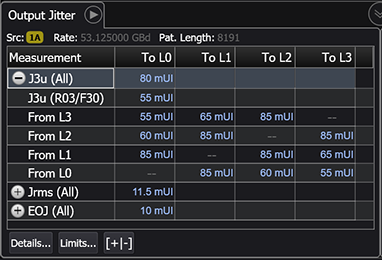12-Edge Output Jitter EOJ Result
The Jitter Mode 12-edge Output Jitter EOJ measurement is based on IEEE 802.3bs standard for Output Jitter measurements. According to the standard, this measurement should be performed using an PRBS13Q pattern. EOJ is a difference between two averaged time positions. When the pattern is continuously running, the accuracy of the EOJ measurement increases as more data (histogram points for even and odd edges) is acquired in the color-grade gray-scale database memory. FlexDCA correctly determines the correct number of pattern repetitions on which to perform the measurements.
On PAM4 signals that are derived from two NRZ signals, this measurement allows you to observe the effect of different uncorrelated jitter on each stream based on the transitioning bits.
The following measurements are shown in the Output Jitter panel:
- EOJ (All)
- As called out in the standard, EOJ is measured from an RJ/PJ histogram and is the combined results from every edge. The maximum value of the 12 waveform transitions are used.
- From Ln to Ln
- These are the RJ/PJ histogram measurements of the 12 individual edge (level) transitions.

 To run this measurement, click the 12-Edge Output Jitter button in the which is located on Jitter mode's Meas toolbar.
To run this measurement, click the 12-Edge Output Jitter button in the which is located on Jitter mode's Meas toolbar.
More Information
SCPI Command
:MEASure:JITTer:OJITter:EOJ